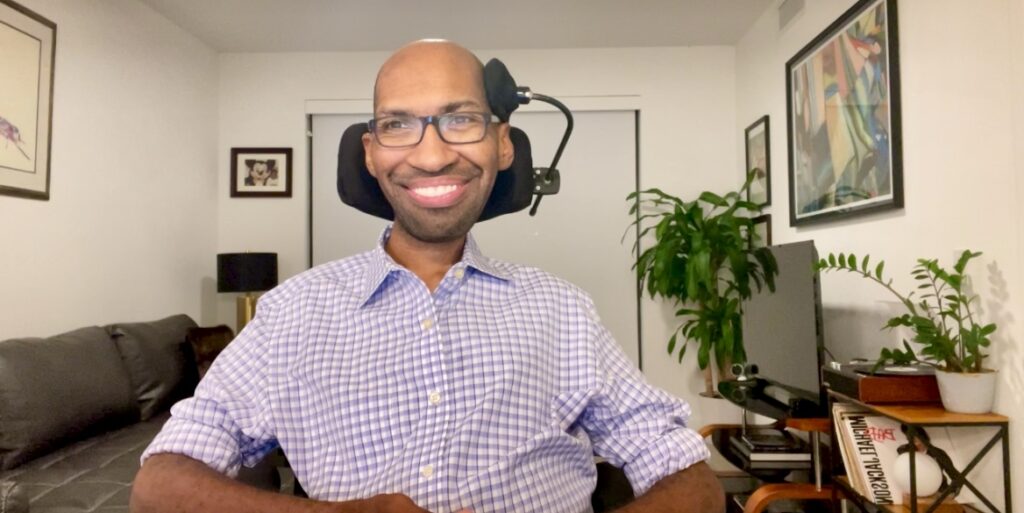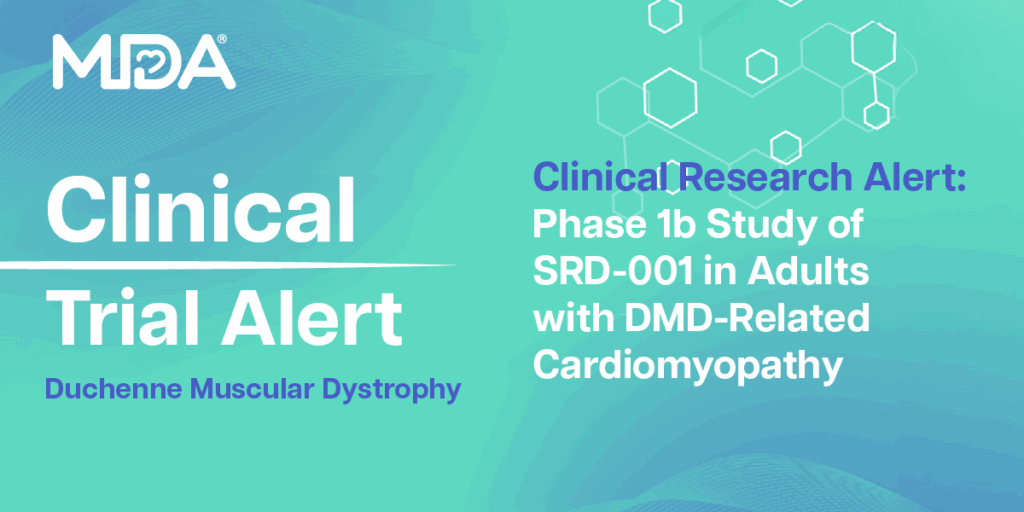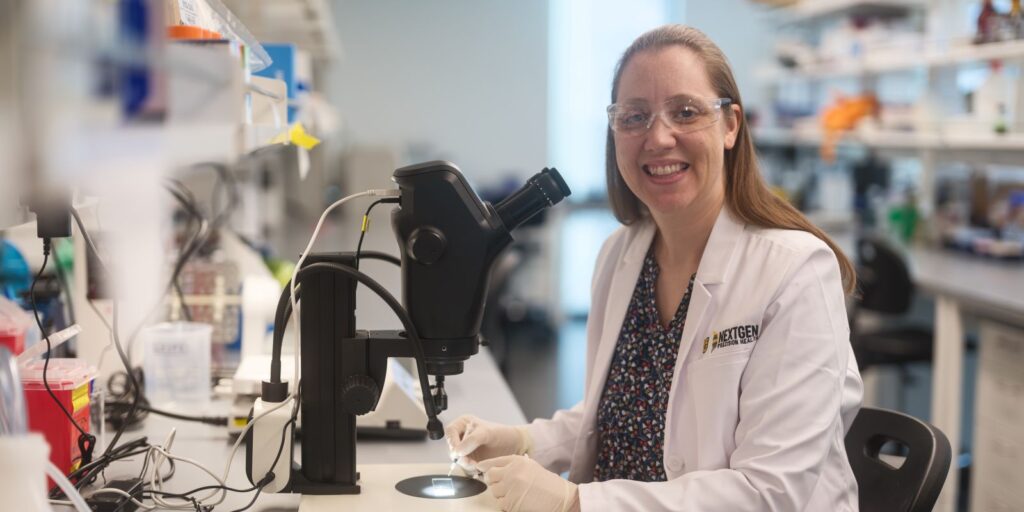
International Day of Women and Girls in Science: MDA’s Spotlight on Dr. Kathryn Moss
By Rebecca Hume | Friday, February 7, 2025
In recognition of International Day of Women and Girls in Science, the Muscular Dystrophy Association (MDA) is honored and excited to highlight the career and accomplishments of Dr. Kathryn Moss, PhD. International Women and Girls in Science Day, February 11, endeavors to acknowledge and celebrate the invaluable role that women and girls play in accelerating change and discovery in the professional realm of science, technology, engineering, and math (STEM). Dr. Moss’s research on the pathogenesis of Charcot-Marie-Tooth disease Type 1A (CMT1A) and hereditary neuropathy with liability pressure palsies (HNPP) aims to identify and better understand the mechanisms behind these diseases – and ultimately, develop therapies to treat them.
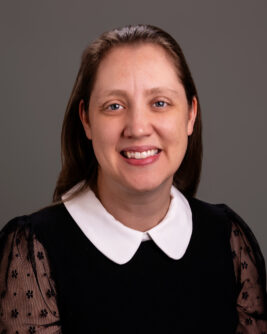
Dr. Kathryn Moss, PhD (Photo credit: University of Missouri)
Dr. Moss earned her bachelor’s degree at the University of Michigan and her PhD at Emory University before completing a postdoctoral fellowship at John Hopkins University. The 40-year-old Michigan native is currently engaged in research at her lab in Columbia, Missouri, where she serves as an assistant professor at the University of Missouri’s NextGen Precision Health and Department of Physical Medicine and Rehabilitation. As someone living with CMT, her pursuit of developing future treatments is fueled by a personal passion to bring innovations in care and hope to others living with the disease.
Dr. Moss shares her journey, research, professional experience, personal motivation, and insight about being a woman in science below.
When did you first become interested in medical research and what motivated you to choose a career in medical research?
I knew from a young age that I had a condition that resulted in certain limitations, like not being able to run on the playground well and being unable to walk in my mom’s high heels. However, I didn’t appreciate the underlying cause of these limitations until I learned more about biology in middle school and high school. I was naturally drawn to science throughout school and my interest in biology was truly fortified while taking AP Biology in high school. This experience solidified my goal of becoming a researcher dedicated to studying the disease that affects both me and other members of my family. Despite this ambition, I had no idea how to turn it into reality; I had never met a scientist and had a complete lack of understanding about the path to becoming one. I knew college was the first step, and through determination and some trial and error, I navigated the process to complete my bachelor’s degree and eventually my PhD. Along the way, I was fortunate to find incredible mentors who guided me on my journey to becoming an Assistant Professor and establishing my own lab.
What is your area of research and what accomplishments have you achieved in your career thus far?
I study Charcot-Marie-Tooth disease (CMT), and I consider myself a molecular and cellular neuroscientist. My overarching goal is to identify molecular and cellular mechanisms driving disease development and progression for specific subtypes of CMT and understand how these diseases affect patients on a system-wide basis so we can develop therapeutic strategies with the best outcomes for patients. My career journey has exposed me to incredible opportunities, like serving as chair of the junior committee for the Peripheral Nerve Society and being the faculty advisor for the University of Missouri student group Care for Rare Mizzou. I have also received several competitive grants and awards for my research including an NIH NINDS K22 Career Transition Award in 2021, Johns Hopkins Helen B. Taussig Young Investigator Award in 2023, and Charcot-Marie-Tooth Association ”40 under 40” Award for Advancing CMT Research and/or Clinical Care in 2023.
What is your current research focus? Can you tell us what you are working on and what your work aims to achieve?
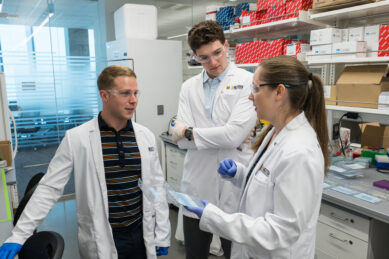
Kathryn Moss, PhD, discussing research findings with two junior scientists. (Photo credit: Ben Stewart at University of Missouri)
My research currently focuses on the most common CMT gene, Peripheral Myelin Protein 22 (PMP22). It is remarkable how little we know about the function of the protein encoded by this gene given that it plays such an integral role in peripheral nerve myelin. Duplicating this gene causes CMT Type 1A (CMT1A), deleting this gene causes Hereditary Neuropathy with Liability to Pressure Palsies (HNPP), and smaller mutations in this gene cause CMT Type 1E (CMT1E). My research is hoping to address three critical questions about PMP22 protein. One, what is the function of this protein in myelin? Two, how is the function of this protein regulated? And three, when is precise expression of this protein in myelin most critical? We believe answers to these basic questions will provide important insight about mechanisms driving CMT1A, HNPP, and CMT1E, and generate knowledge for designing therapeutics to treat them.
What are you most excited about in the current research and treatment landscape for neuromuscular disease in general? And CMT specifically?
We have seen amazing progress with other neuromuscular diseases, like spinal muscular atrophy (SMA) and amyotrophic lateral sclerosis (ALS), in recent years and I am optimistic that this success will spread to the CMT field. There are some clinical trials currently underway for CMT and I anticipate there will be treatment options for some subtypes of CMT in the next five to ten years. This provides hope for a patient community suffering with a relatively prevalent yet underappreciated disease. The first approved therapy for CMT will be a major milestone, but we have seen in other neuromuscular diseases that continued research is needed to keep working towards better or more effective therapeutic options. I am very excited for where the field of CMT research is headed, and I hope patients are feeling hopeful about the growing momentum in recent years.
It is a long and intense road to complete your level of education. What would your advice be to young girls who are interested in STEM but have reservations about the amount of education required?
My advice to young girls interested in STEM but hesitant about the amount of education required is to focus on their passion and dedication. If you truly want to pursue a STEM career, you’ll find the determination to navigate the challenges along the way. While the journey can be long and intense, it’s important to recognize that education is not just a series of hurdles; it’s also an opportunity to explore fascinating topics, develop your skills, and connect with mentors and peers who share your interests. School may feel arduous at times, but the rewards of making meaningful contributions, solving complex problems, and achieving your dreams are more than worth the effort. If you find joy in learning, even in small moments, that will help sustain you through the harder parts of the journey.
Were there people along the way who were role models that motivated or encouraged you to go into this field?
Yes, absolutely. While my personal experience with CMT initially drove my resolve to pursue this career path, my determination was strengthened by the incredible role models I encountered along the way. I was especially inspired by the women in leadership positions during my PhD and postdoctoral training, particularly those who managed to balance the demands of being both successful scientists and dedicated mothers. Their resilience and ability to navigate these dual roles challenged the outdated stigma that one must choose between excelling in science and motherhood. Although this stigma is fading, there remains a noticeable gap in the representation of mothers in leadership positions, which made these role models even more impactful to me.
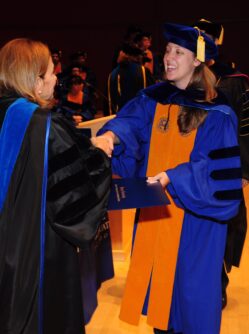
Kathryn Moss, PhD, crosses the stage to accept her doctorate degree at Emory University.
As a young girl, what did you want to be when you grew up?
As a young girl, I initially wanted to be a veterinarian because of my love for animals. However, as I grew older and became more interested in science, I shifted my focus toward research. At the time, I thought pursuing research meant I would need to become a medical doctor, so I briefly considered that path. It wasn’t until I learned that scientists could earn a PhD instead of an MD that I realized a medical career wasn’t necessary to achieve my goals. From that moment on, I was fully committed to the idea of becoming a researcher and never looked back.
What has been the most rewarding part of your career?
The most rewarding part of my career has been the opportunity to make a meaningful impact on both the scientific community and the lives of individuals affected by CMT. Providing guidance to make the path towards a career in science easier for future generations and inspiring people with CMT to pursue research careers brings me immense fulfillment. Training the next generation of scientists and seeing their growth fuels my passion for mentorship and discovery. Advocating for research on the disease that impacts me and my family is a deeply personal mission, and connecting with patients to offer them hope and build community reinforces the greater significance of my work.
Why do you think women make great STEM professionals?
Women make exceptional STEM professionals because they bring diverse perspectives and innovative approaches to problem-solving, which are essential for advancing science and technology. Historically, women have been underrepresented in STEM, and this imbalance has contributed to gaps in medical research and healthcare standards, particularly in addressing the needs of women and other marginalized groups. By ensuring equitable representation, women help promote fair allocation of research funds and amplify diverse voices, fostering ingenuity and collaboration. Their presence in STEM enriches the field, drives creative solutions and ensures that science and technology serve the needs of a broader, more inclusive population.
What advice would you give young women who are considering a career in STEM?
My advice to young women pursuing STEM careers is to stay determined and connect with mentors who will support and advocate for you. While it’s not always easy to find the right mentors, take advantage of the many online resources available, such as LinkedIn, professional organizations, and academic networks, to connect with individuals who can guide and support you on your journey. Fight imposter syndrome by reminding yourself that you belong in these spaces and deserve to pursue your goals. Surround yourself with supportive peers who uplift and motivate you and build a community outside of science to help maintain balance and prevent burnout. Don’t hesitate to cold email professionals whose work inspires you, just be respectful of their time and approach them professionally. Finally, be proactive and aggressive about seeking out opportunities, such as summer research programs and grant mechanisms, to build your skills and strengthen your career path.
What advice would you give to young adults living with neuromuscular disease in general who might be feeling overwhelmed about navigating college/higher education and pursuing career goals?
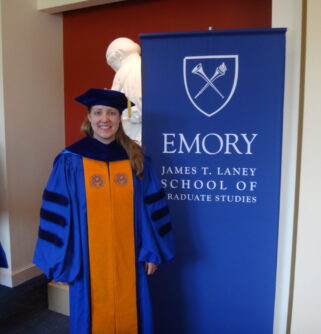
Kathryn Moss, PhD, graduating from Emory University.
To young adults living with neuromuscular disease and feeling overwhelmed about higher education, my advice is to start by building or joining a supportive community of individuals facing similar challenges. Surrounding yourself with people who understand your experiences can be incredibly empowering, creating a space where you can authentically be yourself without navigating the burden of ableist expectations. Consider using tools like a bike or scooter to deal with mobility limitations on campus and reach out to disability centers for academic accommodations and support. Don’t hesitate to send cold emails or attend networking events to connect with mentors who can advocate for you. Patient foundations like MDA, CMTA, CMTRF, and HNF are valuable resources for discovering support networks, educational tools, and career opportunities. Most importantly, don’t set limitations for yourself. Your potential is limitless, and with determination and the right resources, you can achieve your goals.
Next Steps and Useful Resources
- Stay up-to-date on Quest content! Subscribe to Quest Magazine and Newsletter.
TAGS: College, Community, Innovation, Research, Research Advances
TYPE: Blog Post
Disclaimer: No content on this site should ever be used as a substitute for direct medical advice from your doctor or other qualified clinician.


